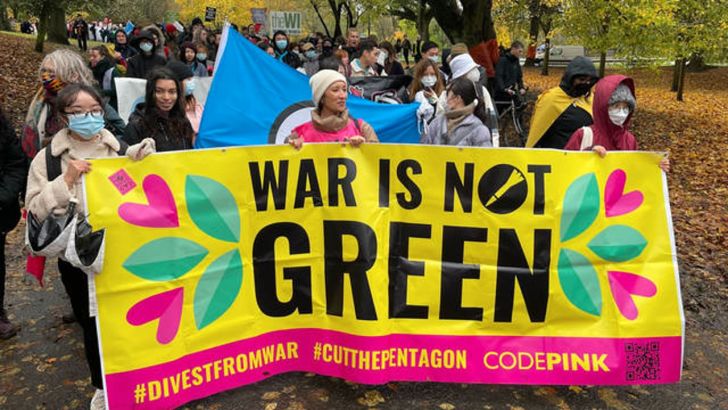The war in Ukraine is not only a human tragedy, but an environmental disaster with exploding chemical plants spewing toxins into the air, rockets increasing greenhouse gasses and warships killing marine life. Much of the fighting is centered in Eastern Ukraine, home to 150 coal mines, more than a dozen nuclear reactors and hundreds of chemical plants.
We made this film to point out why a ceasefire and diplomacy are urgently needed to prevent further destruction of the environment in Ukraine, the entire European continent and beyond. The fate of the human race hangs in the balance.
Ukraine accounts for over a third of the biodiversity of the entire European continent-so as the war drags on, 70,000 species of plants and animals risk extinction.
Here are 10 ways the war in Ukraine has already devastated the environment.
AIR POLLUTION: Russian attacks on Ukraine’s chemical and oil storage facilities have released plumes of smoke with toxic particulate matter, gasses and heavy metals that damage the lungs, worsen air quality and make it difficult to breathe in the industrialized east of Ukraine. Explosions, falling buildings, and trenches and tunnels dug for battle increase the release of particulate matter. Weapons of war–from rockets to missiles to ammunition–emit tons of carbon and particulate matter that pollute the air and increase greenhouse gasses. Rockets can also produce hydrogen cyanide vapor, which can cause acid rain.
FARMLAND DESTRUCTION: Russia’s invasion of Ukraine has caused billions of dollars in damage to Ukraine’s agricultural sector, blanketing crops with land mines and destroying farm machinery. Ukraine is among the world’s largest exporter of grains. To ensure the global food supply, it’s urgent a ceasefire be declared.
WATER CONTAMINATION: Attacks on industrial facilities have resulted in chemicals leaching into rivers and groundwater, contaminating the drinking water for over a million people in the Donbas region. The use of explosive weapons by both the Russians and Ukrainians in the Donbas threatens to collapse a water system already weakened by a decade-long civil war in eastern Ukraine, where ethnic Russians battled Ukrainian nationalists armed by the United States.
DEFORESTATION & GREENHOUSE GASSES: Bombings and fires have not only increased greenhouse gas emissions, but also led to deforestation and the loss of carbon sinks.
INCREASED PRODUCTION OF DIRTY ENERGY: Since the invasion, the US imposed sanctions on Russian oil and gas. US dirty energy companies, which have gained new licenses to increase their exports of LNG and oil to Europe. European companies have also taken advantage of the energy crisis to increase filthy coal-fired power generation and to keep nuclear plants online that were scheduled to be decommissioned.
DEAD DOLPHINS & MARINE HARM: Marine biologists estimate at least 50,000 Black Sea dolphins have been killed as a result of the war in Ukraine–whether the cause is contaminated water, exploding mines or the noise from warships and detonations–dolphin carcasses are washing up on the shores in Ukraine’s Odessa region. The loss of dolphins can upset the ocean’s ecosystem and make it difficult for fish to thrive.
PIPELINE SABOTAGE & METHANE LEAKS: Sabotage of the Nordstrom Pipelines transporting natural gas from Russia to Germany resulted in the biggest single release of methane ever recorded. According to the United Nations, methane traps more heat in the atmosphere per molecule than carbon dioxide (CO2), making it 80 times more harmful than CO2 for 20 years after it is released.
MONEY FOR WAR, NOT FOR CLIMATE: While Western nations pour tens of billions of dollars into weapons and military training to escalate the war in Ukraine the Global South–suffering from drought– waits for promised climate reparations. Congress has approved over $100 billion for Ukraine in 2022, the amount western countries were supposed to pay the Global South each year since 2009–but did not. Whether the US and NATO countries write a check to cover their massive burning of fossil fuels –their overconsumption and militarism that disproportionately impact the Global South remains to be seen.
THREAT OF RADIATION LEAKS: Ukraine has four nuclear power plants with a total of 16 reactors. The Russian occupied Zaporizhzhia nuclear power plant delivers one-fifth of the country’s electricity. It is here at Zaporizhzhya on the eastern bank of the Dnipro river that shelling by Russian and Ukrainian forces has raised the specter of a nuclear catastrophe or meltdown like the one that occurred at the Chernobyl nuclear power plant in 1986. The accident at Chernobyl, located in Ukraine, but then part of the Soviet Union, spread radiation throughout Europe.
THREAT OF NUCLEAR CATASTROPHE: An even greater environmental threat is the threat of nuclear annihilation. The war in Ukraine has become a proxy war between the United States and Russia, the two most nuclear armed nations. Since the invasion, Russian leader Vladamir Putin has issued veiled nuclear threats, saying all options are on the table, while President Biden has warned of nuclear Armageddon if the war escalates. A nuclear war between the United States and Russia could result in a “nuclear winter” that would create global famine and risk the future of life on this planet.
We cannot allow that to happen. Everyone who cares about the environment, both organizations and individuals, should join in the growing call for a ceasefire and peace negotiations now. Sending more weapons to escalate the war in Ukraine undermines the possibility of a diplomatic solution as both sides believe they can win an un-winnable war.




